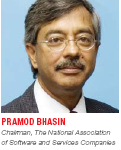 The key challenges are: e-Infrastructure, which is inadequate and uneven. Then there is a need for better awareness and e-Literacy. Capacity is another area of concern, both within and outside of the government, and for long-term sustainability there is an urgent need to address these at the national level. Complex governance structure, size and complexity of the need on the ground, makes implementation models very complex and diffi cult to achieve. Last but not the least, evolving Public Private Partnership (PPP) models, harnessing and engagement of private sector resources is still an issue, which needs to be addressed.
The key challenges are: e-Infrastructure, which is inadequate and uneven. Then there is a need for better awareness and e-Literacy. Capacity is another area of concern, both within and outside of the government, and for long-term sustainability there is an urgent need to address these at the national level. Complex governance structure, size and complexity of the need on the ground, makes implementation models very complex and diffi cult to achieve. Last but not the least, evolving Public Private Partnership (PPP) models, harnessing and engagement of private sector resources is still an issue, which needs to be addressed.
1. Taking a holistic view and arriving at an integrated solution
 2. Enhancing technology penetration to the last mile in
2. Enhancing technology penetration to the last mile in
e-Governance
3. Timely completion of e-Governance projects
4. Capacity building to make e-Governance solutions sustainable in the medium and long term
5. Hiring the right mix of personnel for sustaining the project
1. Lack of high level (cabinet) sponsorship for e-Governance programmes.
2. Lack of interest and understanding of the senior management of the  government in overall e-Governance principals.
government in overall e-Governance principals.
3. Long delays in implementing e-Governance projects due to technical issues or lack or government agency support.
4. Lack of access to Internet , especially for rural population to reap the benefi ts of e-Governance.
5. Lack of ICT HR development and sustainable plan in government

1. Usage and wide promotion of computer literacy in India
2. Reliable connectivity is also a major challenge. If we are talking about  citizens depending on fast, speedy information download from the government services then reliability of the connectivity and network is a big challenge which needs to be addressed today.
citizens depending on fast, speedy information download from the government services then reliability of the connectivity and network is a big challenge which needs to be addressed today.
3. State level government commitment and leadership to adopt and embrace e-Governance
4. Lack of programme management skills have to be overcome by choosing qualifi ed administrators to manage the entire e-Governance network effi ciently.
5. Lack of integration of services offered by the State and Central Government. The information residing with one department is usually not transmitted to the other departments.
1. Lack of systems-driven approach due to lack of compelling need in bureaucracy to opt for e-Governance
 2. Privacy of personal data
2. Privacy of personal data
3. Lack of suffi cient maturity of the procurement machinery to opt for quality based selection over cost based selection
4. Inability of the project sponsors to drive the project without avoiding excessive and motivated public scrutiny and time/cost overruns due to poor project management on government side
5. Inability of IT industry to quickly scale up to the challenge of need of “domain expertise coupled with IT skills” which is imperative for project success
6. Ensuring institutionalisation of e-Government projects after Go-Live.

1. Ensuring stakeholder acceptance and participation towards the successful implementation of e-Governance is one of the most important challenges
 2. Structuring various e-Governence projects in such a fashion that they are self-sustainable to a considerable extent in a longer term is again a prime challenge to ensure that the projects once implemented and operationalised remain in vogue
2. Structuring various e-Governence projects in such a fashion that they are self-sustainable to a considerable extent in a longer term is again a prime challenge to ensure that the projects once implemented and operationalised remain in vogue
3. Defi ning the nation-wide technology standards to ensure inter-operability, cost-effectiveness, relevance and usability
4. Appropriate project and portfolio management at various administrative and executionary levels to have better sense of the progress and corresponding impact, better utilisation of funds, other resources and effective monitoring of projects
5. Addressing security concerns in terms of data privacy and data loss prevention
1. The scale of implementation of e-Governance programmes is huge in terms of number of integration points and meeting training needs etc.
 2. Capacity building – As more and more projects are implemented, government needs to build qualifi ed pool of resources to manage the system
2. Capacity building – As more and more projects are implemented, government needs to build qualifi ed pool of resources to manage the system
3. Diverse language: This is a huge challenge due to the diversity of the country. It lays stress on including local languages in governance. Ensuring e-Governance in local language is a big task to achieve
4. Integration of systems – Most of the e-Governance services being offered by the state or the central government are not integrated.
5. Conceptualisation and implementation of solutions which reach out to the rural and semi-literate population as well
From departmental silos to process delays to lack of accountability – the challenges are aplenty. At IBM, we have seen that smarter government agencies  collaborate across departments and with communities—to become more transparent and accountable, to manage resources more effectively, and to give citizens access to information about decisions that affect their lives. Take the instance of the recent wildfi res in California, where in government agencies turned to Twitter to provide real-time updates on the status of the fi res—directing people without power, but with mobile devices, to Google Maps for evacuation information.
collaborate across departments and with communities—to become more transparent and accountable, to manage resources more effectively, and to give citizens access to information about decisions that affect their lives. Take the instance of the recent wildfi res in California, where in government agencies turned to Twitter to provide real-time updates on the status of the fi res—directing people without power, but with mobile devices, to Google Maps for evacuation information.
The real challenge is how to develop and sustain successful e- Governance projects and deliver state of the art e-Services to citizens. e-Governance should  ideally enable seamless access to information and fl awless fl ow of information across the state and central government in the federal setup. Some of the main challenges are:
ideally enable seamless access to information and fl awless fl ow of information across the state and central government in the federal setup. Some of the main challenges are:
1. Lack of IT literacy and awareness regarding benefi ts of e-Governance
2. Attitude of Government Departments
3. Under-utilisation of existing Information and Communications Technology (ICT) infrastructure
4. Resistance to re-engineering of departmental processes
5.Lack of infrastructure for sustaining e-Governance projects on national level
1. Penetration of Internet and infrastructure issues such as power.
 2. e-Governance is looked at as an IT topic where it is all about transformation and change management
2. e-Governance is looked at as an IT topic where it is all about transformation and change management
3. Little focus from Indian IT companies on Indian projects
4. Lack of experience of Indian companies in implementing and managing large and complex e -Governance projects
5. Insuffi cient IT manpower in Class B cities, towns and villages, and reluctance of IT professionals and companies to work in these areas
1. Issue of availability and affordability of broadband connection. Though the government has and is taking steps to increase the broadband penetration, we  still have miles to go before we realise the full potential of e-Governance. This is critical as the success of many of India’s e-Governance projects hinges on the availability of Internet.
still have miles to go before we realise the full potential of e-Governance. This is critical as the success of many of India’s e-Governance projects hinges on the availability of Internet.
2. Localisation of content. ICT solutions and video content are mostly developed with an English language interface. However, in India a vast majority (95%) of the citizens do not know English and use the local language. The fact is that India has 22 offi cial languages. For the success of e-Governance, this reality needs to be refl ected in the implementation strategy.
1. Business process re-engineering (BPR) is a challenge. Just bringing in technology is not suffi cient. BPR has to be done. The processes have to change  at the ground-level. This is the biggest challenge.
at the ground-level. This is the biggest challenge.
2. The focus in India is on automation rather than having integrated infrastructure. Most of the projects going on in the country are not integrated. What we are creating are ‘Islands of Automated Projects’. There is a need to integrate the initiatives existing in the various departments and ministriesof the government.
3. Automation of the employment exchanges in all the States. Because of the Central versus State subject, this cannot be done at the Central level.
4. Local language computing will be one the main issues. India is a diverse nation in terms of the number of languages spoken. Local language computing is therefore, very essential.
1. The key challenges with electronic governance are not technology or Internet issues in many cases, but organisational issues like redefi ning rules  and procedures, information transparency, legal issues, infrastructure, skill and awareness, access to right information, and tendency to resist the change in the work culture. Change management is important not only in terms of cultural change, but also in terms of changing operations and processes workfl ow that the automated environment will introduce.
and procedures, information transparency, legal issues, infrastructure, skill and awareness, access to right information, and tendency to resist the change in the work culture. Change management is important not only in terms of cultural change, but also in terms of changing operations and processes workfl ow that the automated environment will introduce.
2. The other obstacles are geographical distances, lack of trained human resources, and lack of ICT penetration in remote areas. For instance, a good e-governance application will not benefi t anybody in remote areas if there is no supporting infrastructure, such as electricity, computers and connectivity.
 1. Mindset of government offi cials
1. Mindset of government offi cials
2. Infrastructure support (i.e. power) Connectivity
3. Archaic procedures (Comptroller and Auditor General, Central Vigilance Commission)
4. Resistance to change
1. The biggest challenges are the [political and social] culture and environment, we have in this country. The level of corruption is too high. It demands huge  amount of concerted effort, to root out these evils from this country. Conducive environment is very crucial for implementation of e-Governance plans. In such a context, people’s awareness is also very important.
amount of concerted effort, to root out these evils from this country. Conducive environment is very crucial for implementation of e-Governance plans. In such a context, people’s awareness is also very important.
2. There is a big issue of lack of transparency and delay in the government service delivery, which results in lower effi ciency and productivity. Moreover, the dearth of consistent follow-ups that involves close observation and monitoring of government projects, is yet another challenge in e-Governance.
3. Lack of trust in the ecology: between people and government is a major challenge [that will continue for long]. Our entire system, including judiciary should be such, that people could put their faith into the system.
1. e-Governance is not only or even primarily a technological project. So, in my view, the primary challenges are issues such as: how should we engage users or  benefi ciaries in service design and improvement? How can we incentivise civil servants to engage in service innovation and process change and to enable them to play their new roles required by the re-engineered processes? How can we bridge the gap between online service availability and the take up by the users of infomediaries? How can we encourage coordination and collaboration among public agencies to share information and infrastructure across government and ensure customer centric services?
benefi ciaries in service design and improvement? How can we incentivise civil servants to engage in service innovation and process change and to enable them to play their new roles required by the re-engineered processes? How can we bridge the gap between online service availability and the take up by the users of infomediaries? How can we encourage coordination and collaboration among public agencies to share information and infrastructure across government and ensure customer centric services?
2. One fi nal and continuous key challenge is the development of leaders and change managers to inspire institutional change, support collaboration, and engage in all sorts of public process and service innovation.
 1. Political instability
1. Political instability
2. Corruption
3. Frequent transfer of government employees
4. Lack of coordination between government agencies
5. Short sighted policies
1. Mindset of politicians, bureaucrats, judiciary and businessmen
2. Lack of transparency and accountability in the working of government and public authorities
3. Lack of enforcement mechanisms to ensure e-Governance truly benefi ts the masses
4. Lack of Unique Identity to every citizen and lack of enforcement of identity tracking in elections and all transactions
5. Corruption at all levels of governance
Be a part of Elets Collaborative Initiatives. Join Us for Upcoming Events and explore business opportunities. Like us on Facebook , connect with us on LinkedIn and follow us on Twitter, Instagram.











